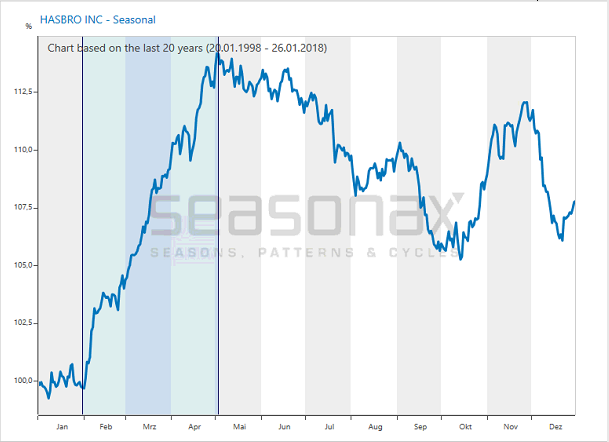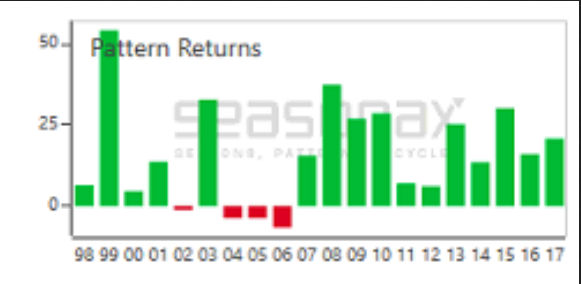You have probably heard about the Halloween effect or the autumn rally. The former term refers to the fact that stocks on average tend to perform significantly worse in the summer months than in the winter months, the latter term describes the typically very strong advance in stocks before the turn of the year.
Both phenomena apply to the broad stock market, i.e. the benchmark indexes.
A number of individual stocks have their own “seasons”.
However, certain individual stocks can diverge from the indexes and exhibit seasonal patterns of their own. I will illustrate this with an example.
Hasbro (NASDAQ:HAS): seasonal strength from February to April
I have picked Hasbro, a manufacturer of toys headquartered in Pawtucket, Rhode Island, US. You are very likely familiar with one of the company's products: Monopoly (a board game originally made by Parker Bros.).
Take a look at the typical pattern the stock exhibits in the course of a calendar year, which can be discerned at a glance on a seasonal chart. The chart below is calculated by averaging the performance of the stock over the past 20 years. The horizontal axis depicts the time of the year, the vertical axis the level of the seasonal pattern (indexed to 100).

As the chart shows, Hasbro typically rallies very strongly in the three months to the end of April, but on the other hand the stock's seasonal pattern indicates that it tends to lose ground over the rest of the year.
The time period associated with the strongest seasonal performance is highlighted on the chart. It begins on January 31 and ends on May 2.
Hasbro's very positive performance at this time of the year diverges from that of benchmark indexes like the S&P 500. In seasonal terms, the latter typically barely rises in February, while it usually displays significant strength at the end of the year.
How frequent were rallies in Hasbro during the seasonally strong period? After all, it is theoretically possible that an outstanding performance in just a single year was responsible for this strong gain.
Hasbro rose in 16 of 20 cases from January to May
The bar chart below depicts the average return delivered by Hasbro shares in the relevant time period from January 31 to May 2 in every year since 1998. Red bars indicate years in which negative returns were generated, green bars indicate years with positive returns.

On just four occasions the stock posted small losses. (Source: Seasonax)
As can be seen, the green bars predominate both in terms of size and frequency. There were 16 rallies, while relatively small price declines were recorded in the remaining four years.
In short, the gains were widely distributed.
Take advantage of the strongest seasonal periods
As you can see, individual stocks can exhibit seasonal patterns of their own. This means that a great many more seasonal patterns exist in the stock market than the indexes alone would suggest.
Where can one obtain information on the seasonal trends of individual stocks? Call up “APPS SEASON” on your Bloomberg Professional Terminal, or enter the App Studio in the Thomson Reuters Eikon menu and call up the Seasonax App from there. You can select any listed stock by entering its symbol into the text field of the app and quickly identify the most promising seasonal patterns.
You can also examine how your preferred stocks respond to numerous events such as for instance the release of important economic data, or monetary policy decisions by the Fed.
